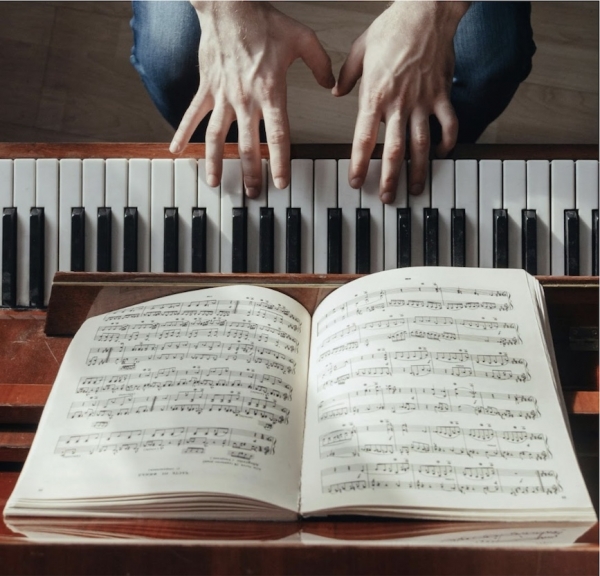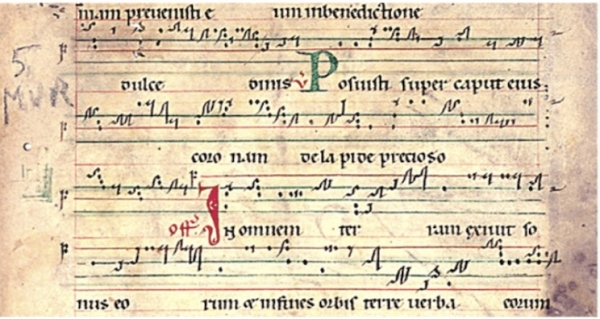
Photo by Anastasia Kolchina
The digital age has provided so many more tools and resources at our fingertips, especially when it comes to sheet music. You can search for literally any song you want and find large catalogs of music to play or sing.
Sheet music is a broad term for any written form of music. Individual pieces, simple scores, books, and more are all considered within the sheet music category. The evolution of sheet music before the 15th century was all written by hand, unlike how easy it is to come across a digitally prepared piece today.
Here’s a look at the evolution of sheet music from scores to screens:
Hand-Written Sheet Music
Creating music by hand and binding it together through manuscripts was challenging and time-consuming for composers and songwriters. The music transcribed back then may look very different from what you think sheet music to look like today.
Music notation, with written symbols and signs, later adding in notes and lines as the first form of sheet music, progressed from
clay tablets to written paper. The ancient Babylonians began writing music on tablets almost 4,000 years ago. Before that, it’s hard to even know what music sounded like, though there are some prehistoric instruments to give clues as to what it may have been.
The music notations on paper were later developed more by ancient Greeks and Romans. In the 7th century, Catholic monks used ink with quills on parchment to create sheet music, and these volumes were mainly composed of
religious monophonic chants.
Neumes are a significant aspect of the history of sheet music in the 9th century. Neumes are known as a musical notation or sign for one group of successive musical pitches. They were the early forms of modern music notes.
European church musicians utilized them to write down these religious chants that previously were only provided through oral traditions; they look somewhat similar to the lines and notes we are familiar with in sheet music today:
Polyphony and Pneumatic Notation in Sheet Music
Polyphony was introduced around the 9th century and became an essential musical force during the Renaissance era. With the introduction of the printing press in the 15th century, sheet music was printed and became far more accessible to the public.
The printing press still posed many challenges for sheet music. The music was complex, so even with the printed pieces, many of the required notes and notations still needed to be added by hand. The
first machine that didn’t require these additions was created approximately 20 years after the printing press's creation. And it required three passes through the press for the final product.
Pneumatic notation was created around this time, with signs and symbols above the text that indicated the melody. As the Middle Ages progressed, music notation became more specific.
The names of musical notes in solfege, such as "do, re, mi," have origins in a poem written by a Benedictine monk.
The monk’s name was Guido de Arezzo, and he developed a system of accurate notation in music using lines and spaces to separate each individual note. He gave names to the notes, which is where we get the alphabetic note names we use today. A B C D E F G – based on what we call the natural minor scale, Guido would have called it a mode.
"Ut queant laxis" was the title of this particular poem. The first stanza is:
Ut queant laxīs
resonāre fibrīs
Mīra gestōrum
famulī tuōrum,
Solve pollūtī
labiī reātum,
Sāncte
Iohannēs.
Translation: So that your servants may, with loosened voices, resound the wonders of your deeds, clean the guilt from our stained lips, O Saint John.
A paraphrase by Cecile Gertken, OSB (1902–2001), preserves the key syllables and loosely evokes the original meter:
Do let our voices
resonate most purely,
miracles telling,
far greater than many;
so let our tongues be
lavish in your praises,
Saint
John the Baptist.
The notation system that helped shape and define things like sharps, flats, rests, and more resulted from centuries of innovation and development. Musical composers and musicians had to constantly work together to standardize and unify these widely recognizable elements to make up piano sheet music.
Sheet Music Distribution
During the development of printed sheet music in Europe at this time, the growth of sheet music became more widespread. It became far easier for composers and musicians to write, read, obtain, and perform music.
By the 19th Century, sheet music publishing was thriving in Europe and the United States. The material was more accessible, and the ability to send full-fledged scores to different parts of the world provided orchestras, symphonies, and other amateur pianists with varying music to perform.
Music publishers became commonplace within the community, as those businesses could build upon the distribution of music. Today, these institutions are still primarily responsible for printing, distributing, and managing musicians' and composers' copyrights.
Sheet Music in the Modern Era and the Digital Age
From the 16th to the 18th centuries, musical notation for piano sheet music evolved to a form more like what we see today. Elements that included musical theory fundamentals like key signatures, notes and lines on the staff, dynamics, and tempo markings were more refined to indicate how the music would be played.
Musicians and composers have a wide range of notation sheet music software and digital programs that allow the creation, editing, and sharing of musical scores with simple mouse clicks and typing on a computer. It’s incredible how technology has evolved to enable piano sheet music and chords to be available at the touch of a button.
For example, you can effortlessly search for
beginner acoustic guitar chords and quickly copy, paste, or share them on a computer screen or mobile device. Plenty of online resources allow you to quickly download and print sheet music from the comfort of your home. Musicians can also search and discover new and trending genres, from K-pop to Seapunk and Afrobeat, for new inspiration.
Composers can work with a tablet right at their piano, quickly playing out a musical piece and having it immediately transfer to their device, with the ability to make quick fixes and adjustments as they go. The programs they utilize offer very high levels of accuracy, so there’s more control over all aspects of the musical composition, from note duration to articulation, tempo, and dynamics.
The use of the terms “sheet” and “score” came later, after the first printed sheet music, to differentiate written and printed forms of music from sound recordings or video footage.
It’s also considerably impacted the movie scene to come up with and create music on the fly. Without the need to constantly borrow and pay royalties, musicians and independent artists can use technological advances to quickly produce a movie score.
The Future of Sheet Music
Technology is ever-changing, so it’s no surprise that the way sheet music is written, handled, and shared could also change in the future.
Plenty of new systems and programs are coming out with ways to notate music that provide more user-friendly experiences. With the surge of artificial intelligence (AI), machine learning, and modern-era digital online sites, including MainlyPiano, piano sheet music can be easily produced by independent musicians, recording studios, composers, and anyone with the desire and knowledge of music theory to write their own tracks!
From ancient roots of writing by hand to the screen-sharing capabilities of digital forms, sheet music has had a long history of human creativity and expression. Understanding the origins allows for more appreciation of the music we hear today and the work that goes into its development.
About Donna Maurer:
Music has been Donna's lifelong companion, and her expertise spans both piano and guitar. With a career spanning five enriching years in various music schools across New York, Donna is a music teacher and an artist. Her teaching philosophy extends beyond the technicalities, instilling a deep understanding of music theory and a genuine appreciation for the art form itself.


